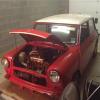I have seen the titanium front subframe from force racing and was wondering if anyone made an aluminium one as it would be lighter and a lot cheaper like the rear beams as force racing titanium beam is twice as expensive as its aluminium counterpart.
Aluminium Subframe
#1

Posted 20 May 2013 - 07:27 PM
#2

Posted 20 May 2013 - 07:32 PM
Is it a case were aluminium simply wouldn't be up to the stresses involved?
#3

Posted 20 May 2013 - 07:36 PM
You could build an aluminium subframe but it would need a total redesign to suit the material and would definitely need to be heat treated.
A better option for a cheaper light weight subframe would to T45 or CroMoly steel but they'd still be pricey.
#4

Posted 20 May 2013 - 07:37 PM
Well, yes. Not without making it very, very thick.
#5

Posted 20 May 2013 - 08:03 PM
#6

Posted 20 May 2013 - 08:06 PM
#7

Posted 20 May 2013 - 08:54 PM
most modern cars are made out of aluminum...so don't think it would have to be that thick, just made with the right braces...
#8

Posted 20 May 2013 - 09:10 PM
Very few modern mass production cars are made from aluminium in many structural areas. As said above it would need to be completely redesigned, or if made to the standard design would have to be quite beefy. I've had a production car with all ally suspension written off in a very low speed collision (in which my vehicle was actually parked) simply because the ally deforms so easily. How stiff the material is would be a more important consideration than outright strength in a standard subframe to avoid problems with deformation. To get the same stiffness the frame would have to be about 3 times as thick as a steel one, and as ally weighs a third as much as steel per volume there would be little or no saving. So it would have to be very heavily redesigned to give it better support over much more closely spaced mountings.
#9

Posted 20 May 2013 - 09:44 PM
In order to properly design an aluminium sub-frame you would need to have all the dynamic and static loads, which you could get from a series of strain gauges and a full test programme. Then the necessary design and stress analysis could be carried out using a 3D CAD system with a good structural analysis package. Someone with good aircraft design experience could do this, given the right input data.
Aluminium WILL fatigue, not MIGHT fatigue, and life prediction by calculation is vital as is proper design.
The cost of doing this would be very high and that is without the actual manufacture of the item.
#10

Posted 21 May 2013 - 12:09 PM
Considering that several car manufacturers have had a fairly recent track record of fatigue cracking in steel structures (certain BMW rear suspension mounts and Audi wishbones come to mind), I do have to wonder how safe the latest and expensive alloy-structured cars actually are. It only needs the owner to run it for a higher mileage, or manage to subject it to higher loads, than the designer expected and there is serious danger. Classic car owners beware too, the Triumph 2000 and presumably the TR series had alloy rear radius arms, and they are known to fail.
Don't get me going on wheels, or calipers, or certain parts made for Minis....
The K series engine is clever because, amongst other things, the alloy block is held in compression by the steel through bolts so the fatigue effects are minimal.
#11

Posted 21 May 2013 - 01:56 PM
I'd also think it'd be a nightmare in a crash. Mini's have precious little deformation structure, making an ally subby solid enough for the suspension loads is going to make it even more solid, and less deformable than the thinner steel sections.
#12

Posted 21 May 2013 - 02:41 PM
Thanks for the replies I am tempted to save money and go the diy route rather than buy a full out titanium one.
#13

Posted 21 May 2013 - 03:36 PM
I'm no Mini expert by any means (as can be seen from my posts)....
But having taken my first one apart and put it all back together again I have been struck by how amazingly heavy some of the parts are...
I can't help but think there must be much easier (and safer) ways of saving a few Kg than drilling random holes in major structural parts like subframes...?
#14

Posted 21 May 2013 - 05:52 PM
With commercial aircraft it is a requirement to have a ground-based structural test rig which operates to simulate the flight loads on an aircraft and the test rig must always be well ahead of the highest number of hours and flight cycles of the most highly used aircraft of that type.
Like 'tiger', I'm always very sceptical of aluminium alloy structural or suspension parts on production cars as I'm not convinced the true fatigue implications are considered. On race cars it may be different as the life is limited and the use is clearly defined.
#15

Posted 22 May 2013 - 07:19 AM
Yes, a race car, especially in Formula 1, where progress is rapid, will never last long enough for reasonably well designed parts to reach the end of their fatigue life. A racing Mini also covers relatively few miles, which is why it "may" be safe with alloy callipers, hubs, radius arms etc. However, any of these parts could be potentially lethal on a road car, which is going to cover a very much higher mileage, often on a rougher road surface.
It is certain, due to the enormous costs involved, that the suppliers of many Mini parts have not performed adequate fatigue life tests on their products, despite what they may claim. It is also likely that those who have done some fatigue testing on a hydraulic rig (potentially much faster and obviously safer than driving a car around night and day till something breaks) have underestimated the peak loads involved, and only a small error can have a massive effect on the fatigue life.
1 user(s) are reading this topic
0 members, 1 guests, 0 anonymous users


















